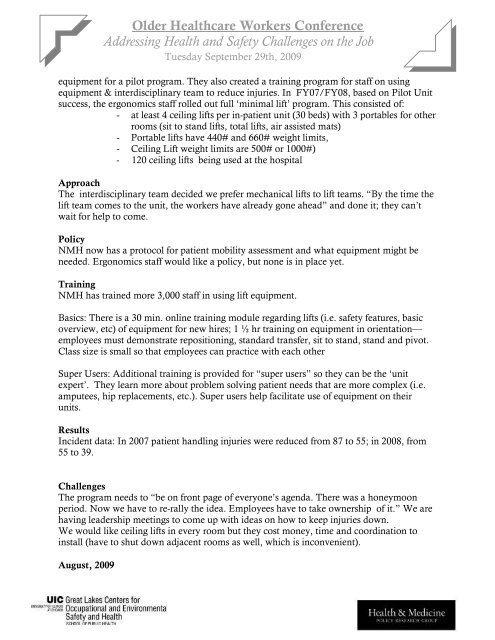Employer Case Examples - Health & Medicine Policy Research Group
Employer Case Examples - Health & Medicine Policy Research Group
Employer Case Examples - Health & Medicine Policy Research Group
You also want an ePaper? Increase the reach of your titles
YUMPU automatically turns print PDFs into web optimized ePapers that Google loves.
Older <strong>Health</strong>care Workers ConferenceAddressing <strong>Health</strong> and Safety Challenges on the JobTuesday September 29th, 2009equipment for a pilot program. They also created a training program for staff on usingequipment & interdisciplinary team to reduce injuries. In FY07/FY08, based on Pilot Unitsuccess, the ergonomics staff rolled out full ‘minimal lift’ program. This consisted of:- at least 4 ceiling lifts per in-patient unit (30 beds) with 3 portables for otherrooms (sit to stand lifts, total lifts, air assisted mats)- Portable lifts have 440# and 660# weight limits,- Ceiling Lift weight limits are 500# or 1000#)- 120 ceiling lifts being used at the hospitalApproachThe interdisciplinary team decided we prefer mechanical lifts to lift teams. “By the time thelift team comes to the unit, the workers have already gone ahead” and done it; they can’twait for help to come.<strong>Policy</strong>NMH now has a protocol for patient mobility assessment and what equipment might beneeded. Ergonomics staff would like a policy, but none is in place yet.TrainingNMH has trained more 3,000 staff in using lift equipment.Basics: There is a 30 min. online training module regarding lifts (i.e. safety features, basicoverview, etc) of equipment for new hires; 1 ½ hr training on equipment in orientation—employees must demonstrate repositioning, standard transfer, sit to stand, stand and pivot.Class size is small so that employees can practice with each otherSuper Users: Additional training is provided for “super users” so they can be the ‘unitexpert’. They learn more about problem solving patient needs that are more complex (i.e.amputees, hip replacements, etc.). Super users help facilitate use of equipment on theirunits.ResultsIncident data: In 2007 patient handling injuries were reduced from 87 to 55; in 2008, from55 to 39.ChallengesThe program needs to “be on front page of everyone’s agenda. There was a honeymoonperiod. Now we have to re-rally the idea. Employees have to take ownership of it.” We arehaving leadership meetings to come up with ideas on how to keep injuries down.We would like ceiling lifts in every room but they cost money, time and coordination toinstall (have to shut down adjacent rooms as well, which is inconvenient).August, 2009


